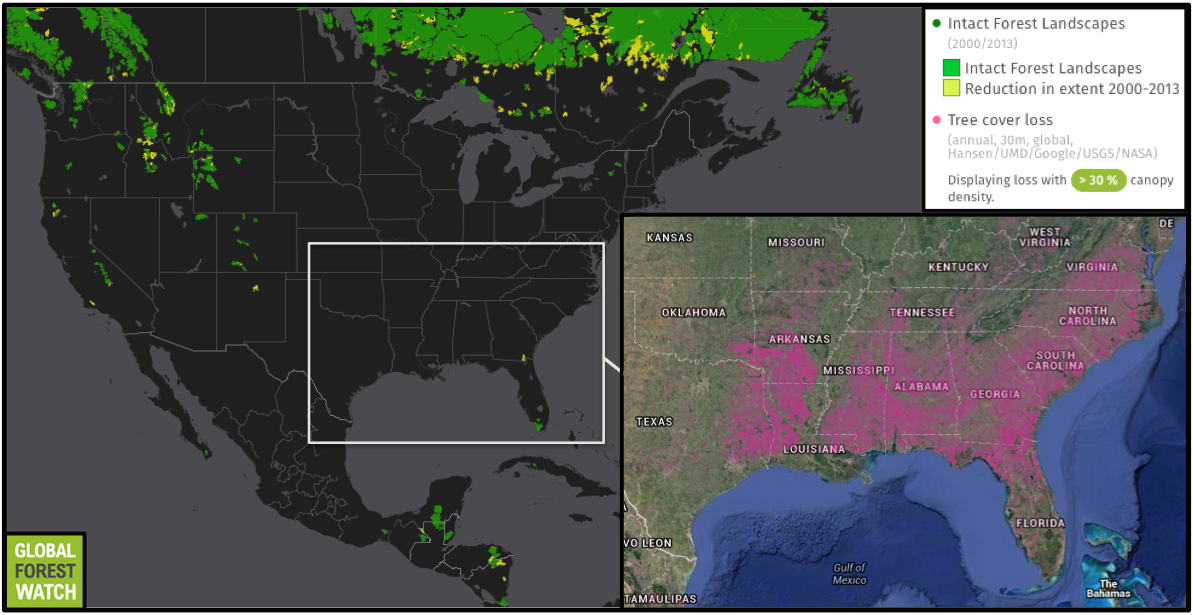- The forests of the southern states have been providing much of U.S. lumber for centuries, with 12 percent of the world’s wood products sourced from the region in 2011.
- A new publication from the United States Forest Service shows the number of lumber mills in the South has been greatly reduced in the past few decades.
- But the head of a major conservation organization working in the area warns that logging is still a big issue in the region, one that is likely to grow in the coming years as demand increases for renewable energy.
The forests in the southern U.S. have been hotbeds of logging over the past two centuries, and currently supply 12 percent of the world’s wood products and 19 percent of its pulp and paper. A new interactive storymap produced by the U.S. Forest Service (USFS) shows the number of active processing mills in the region has been trending downward over the past decades. But conservationists who work in the region say logging is still decimating the once-vast forests of the South.
The southern U.S. comprises 13 states from Texas to Virginia and encompasses a broad range of landscapes and ecosystems. Its forests are home to many threatened species found nowhere else like the southern hognose snake (Heterodon simus), the gopher tortoise (Gopherus polyphemus), and the critically endangered red wolf (Canis rufus).
The South’s forests are also home to big timber industries. While the southern U.S. contain just 2 percent of the world’s forest cover, it produces 12 percent of the world’s industrial roundwood and 19 percent of its pulp and paper products – that is, they are more industrially productive than any other forest in the world.
“The forests are highly productive, providing raw materials that fuel regional, national and global economies,” write the authors of the USFS storymap. These states are known as the nation’s “wood basket,” accounting for 63 percent of the total timber volume harvested in the U.S. in 2011.


Called “Southern Forest Products – An Economic Engine,” the storymap was developed by researchers with the USFS and uses data from the Forest Service Inventory and Analysis (FIA) along with Esri’s (Environmental Systems Research Institute) ArcGIS Online (AGOL) platform. The map, according to a release from the USFS, provides regular updates on timber product outputs and processing mills in the South, as well as shows how activity has shifted over the past decades.
The storymap has different layers that denote outputs for various wood products; users can access these for specific products, and map information for products at the county, state and regional levels. One of the layers in the map lets users explore individual mills for information on types of wood mixes used and helps provide information such as the number of mills in each state. For example, the storymap shows there are more than 1,400 primary wood processing mills currently distributed across the southern United States with about 100,000 employees.
“This is the first of a suite of AGOL-based storymaps we’re developing using FIA data,” said Chris Oswalt, a research forester with the USFS’s Southern Research Station. “The storymap platform allows us to tell a more captivating story, which increases the reach of the data and engages partners we haven’t worked with before.”
The USFS hopes that its storymap will be used to help convey information and strengthen relationships between state forestry agencies in the southern U.S.
“In addition to telling a story, the interface helps us provide the current information our industry, state, and other partner[s] are already asking for in a format they can adapt to their own purposes,” Oswalt told Mongabay.
Southern forests are still feeling the pressure
The storymap shows that mill activity in all southeastern states has been declining over the past decades. Tennessee has seen the steepest drop, from around 1,300 mills in operation in 1960 to fewer than 300 in 2011.
Yet, this drop in processing mills doesn’t necessarily mean a drop in timber harvesting. A USFS study on which the storymap was partly based states that rather than falling, Timber Product Output (TPO) has actually been on the rise in the recent past, peaking at 6.39 billion cubic feet (181 million cubic meters) in 2005.
“Even though market decline seems to be a central message in the story on page 5, the market pressure on and competition for the region’s forests is still tremendous,” said Executive Director of the Dogwood Alliance, Danna Smith. “In fact, [tree cover disturbance] in the Southern U.S. was four times (higher than) that of South American rainforests from 2000 to 2012.”

Smith said that a reduction in the number of mills doesn’t correlate to a drop-off in production since today’s processing technology allows far more efficiency than in decades past.
“Mill automation and consolidation since 1953 has played a major role historically as it has allowed greater production volumes with fewer mills and less people,” she said. “When you look at the graph presented, it looks like the bottom has been falling out of the Southern forest market but that certainly isn’t the case.”
Smith told Mongabay that while she thinks the kind of information conveyed by the USFS storymap is useful in relation to markets, it may not be as helpful when it comes to gauging the state of southern forests.
“In addition,” Smith said, “the data is not as up to date as it needs to be and therefore the story fails to include one of the most significant recent upwards trends in the Southern forest market – wood pellets for export, which have exploded since 2011, increasing from two million tons to 4.4. million tons in 2012.”

The storymap’s data currently extends to 2011 (although USFS’s Oswalt said it can and will be updated), which, Smith says, leaves out an important window.
“A lot has happened over the past 4-5 years as the South has become the world’s largest wood pellet exporter, mostly to Europe where they are being burned to generate electricity,” she told Mongabay. “Volume of exports jumped from almost nothing in 2010 to 4.85 million tons in 2014. Some two dozen wood pellet facilities are currently consuming up to 10 million tons of wood annually. This market is projected to remain on an upward curve over the coming years.” Plus, 20 new planned pellet export mills are expected to be constructed in the next two years, she said, for a total annual export capacity of about 13.2 million tons, which will consume up to 25 million tons of wood annually by 2017.
Twenty-five million tons of wood is roughly equivalent to 1.5 billion cubic feet, according to the storymap’s own conversion metric. So, in other words, wood pellet exports are expected to go from around zero to 25 percent of 2005 peak output levels in seven years.
“Every market has its downward trends, and there is no doubt that from about 1998 there was a general downward trend in the Southern timber market; however, overall demand has increased since 1953, and is expected to increase in 2014-2015,” Smith said.


Given that this is the world’s largest wood producing region, Smith said a few years of downturn in the forestry industry wouldn’t be enough to make up for decades of intensive logging. Natural forests are being lost to intensively managed pine tree plantations, she said. In the Southeastern U.S., plantations make up 20 percent of the forests, Smith said, and in the coastal plain where industrial logging is most concentrated, plantations make up 27% of the forest.
“Yet, in spite of all the plantations, half of the timber products in the region still originate from the logging of natural forests,” she said. “The current rate and scale of logging is a serious issue. We can and must do better. New corporate and government policies have the potential to create markets that actually encourage landowners to grow forests for carbon sinks, storm protection, biodiversity and water filtration.”
Given that this is the world’s largest wood producing region, Smith said a few years of downturn in the forestry industry wouldn’t be enough to make up for decades of intensive logging. Natural forests are being lost to intensively managed pine tree plantations, she said. In the Southeastern U.S., plantations make up 20% of the forests, Smith said, and in the coastal plain where industrial logging is most concentrated, plantations make up 27% of the forest. “Yet, in spite of all the plantations, half of the timber products in the region still originate from the logging of natural forests.”
Data from the University of Maryland visualized on Global Forest Watch shows the southern U.S. lost around 16 million of its 90 million hectares of tree cover (which includes both tree plantations and forest) from 2001 through 2014. In other words, the South lost 18 percent of its overall tree cover in a decade and a half.
To help reverse this trend, Smith urges the creation of new policies that would encourage people in the South to grow forests on their land. Doing so, she says, would create carbon sinks, provide ecosystem services like storm protection and water filtration, and help preserve biodiversity.
“The current rate and scale of logging is a serious issue,” Smith said. “We can and must do better.”